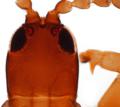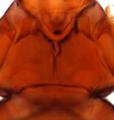Plectrothrips crocatus
Recognition data
Distinguishing features
Female fully winged. Body brown, with tarsi, tibiae and apices of femora yellow; tube yellowish brown; antennal segments II–VIII light brown; fore wings weakly shaded. Head slightly longer than wide, without sculpture medially; postocular setae arise near lateral margins, well behind eyes; maxillary stylets retracted to postocular setae, about one fifth of head width apart. Antennae 8-segmented; segment II with sensorium in basal half of segment; segments III–IV rather truncate at apex, III with 2 sensoria, IV with 3 sensoria; VIII slender, constricted to basal neck. Pronotum narrower than prothorax, only epimeral setae long. Fore tibia apparently with small tubercle at inner apex; fore tarsus with large tooth. Mid tibiae with stout apical spine; hind tibiae with two stout apical spines. Fore wings parallel sided, about 17 duplicated cilia present. Metanotum with faint linear reticulate sculpture; one pair of slender median setae. Pelta broadly triangular; tergite II strongly eroded laterally; tergites with one pair of weak sigmoid wing-retaining setae; tergite IX setae S1 about as long as tube; tube constricted apically. Sternites V–VII laterally with transverse row of iridescent reticulation presumably associated with glandular areas.
Related and similar species
The genus Plectrothrips currently includes 32 described species (Okajima, 1981), mainly from tropical countries. Four species are described from North America, two from Florida, one from Illinois, and one from California. Despite this, the four original specimens of P. crocatus from which this species is known could well be interpreted as large individuals of the Illinois species, P. antennatus, given that other members of this genus are known to be variable in size.
Taxonomic data
Current valid name
Plectrothrips crocatus Cott
Original name and synonyms
- Plectrothrips crocatus Cott, 1956: 80
Family placement
Phlaeothripidae, Phlaeothripinae
Biological data
Life history
Breeding on dead branches
Host plants
Unidentified fungal hyphae on dead branches
Tospoviruses vectored
None
Crop damage
None
Distribution data
Area of origin
Presumably western USA
Distribution
California






